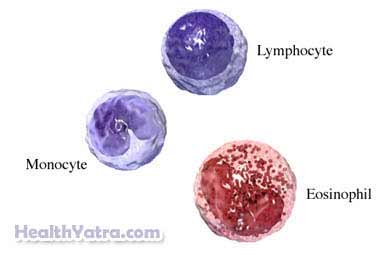Definition
Chronic lymphocytic leukemia (CLL) is a cancer of the blood and bone marrow. Lymphocytes are a type of white blood cell. With CLL, the bone marrow makes too many of these cells. CLL begins in mature lymphocytes. It may be slow growing for many years. You may have little or no trouble. It may also progress to acute lymphoblastic leukemia (ALL), a more aggressive form of leukemia. Some forms of CLL may be more serious. This is because leukemia involves the cells of the immune system. These cells are needed to resist infection.

Cancer occurs when cells in the body become abnormal. They divide without control or order. Leukemia is cancer of the white blood cells and their parent cells. Leukemia cells do not function normally. They cannot do what normal blood cells do. In this case, they cannot fight infections. This means that the person is more likely to become infected with viruses or bacteria. The cancerous cells also overgrow the bone marrow. This forces other normal components, like platelets, out. Platelets are needed to help the blood clot. As a result, people with leukemia may bleed more easily.
CLL can also be associated with the presence of chronic lymphocytic lymphoma. This is a small cell non-Hodgkin’s lymphoma. The abnormal cells in both cases may come from the same parent cell source. As a result, one of the signs of CLL may be swelling in the lymph nodes.
Causes
The exact cause of CLL is unknown. Changes in chromosomes that occur during life have been associated with CLL. It is also associated with exposure to radiation and to toxic chemicals such as:
- Benzene (common in agriculture, paint manufacture, and dye manufacture)
- Agent Orange (an herbicide used in the Vietnam war)
Risk Factors
The following factors increase your chance of developing CLL:
- Age: Middle age or older
- Sex: Male
- Race: White
- A family history of CLL or cancer of the lymphatic system
- Having relatives who are Russian Jews or Eastern European Jews
- Exposure to Agent Orange
Symptoms
Symptoms include:
- Painless swelling in the neck, underarms, stomach, or groin
- Tiredness
- Paleness (a sign of anemia)
- Pain or a feeling of fullness below the ribs
- Fever
- Infection
- Unexplained weight loss
- Reduced exercise tolerance
- Bone pain
- Enlargement of liver and spleen
Diagnosis
Your doctor will ask about your symptoms and medical history. A physical exam will be done. The doctor may also check for swelling of the liver, spleen, or lymph nodes. The nodes may be in the armpits, groin, or neck. You will likely be referred to an oncologist. This is a doctor who specializes in treating cancer.
- You may need to have tests of your bodily fluid. This can be done with:
- Blood tests
- Bone marrow aspiration
- Bone marrow biopsy
- Spinal tap
- Routine microscopic exam
- Bone, blood marrow, lymph node tissue, or cerebrospinal fluid tests
- Cytogenetic analysis
- You may need to have pictures taken of your bodily structures. This can be done with:
- Chest x-ray
- CT scan
- MRI scan
- Gallium scan and bone scan
- Ultrasound
Treatment
Talk with your doctor about the best plan for you. Treatment options include:
Watchful Waiting
A doctor monitors the progress of the disease. Other treatment is not started until symptoms appear to change and become a problem. During this time, other problems, including infection, can be treated. Watchful waiting is often used in low-risk CLL. Some patients may go for many years before more aggressive treatment is needed.
Radiation Therapy
This therapy is the use of radiation to kill cancer cells and shrink tumors. For CLL, external radiation therapy is used. The radiation is directed at the tumor from outside the body. This treatment is used to treat the brain and spinal cord when indicated. It is also used to treat lymph node issues.
Chemotherapy
Chemotherapy is the use of drugs to kill cancer cells. It may be given by pill, injection, or via a catheter. The drugs enter the bloodstream and travel through the body. It kills mostly cancer cells, but also some healthy cells.
Surgery
A splenectomy may be done. This is a surgery to remove the spleen.
Monoclonal Antibody Therapy
This therapy uses antibodies made in a lab. The antibodies help to identify substances on cancer cells or on normal cells that may help cancer grow. The antibodies attach to these substances. This kills the cancer cells, blocking their growth, or preventing them from spreading.
Chemotherapy With Stem Cell Transplant
Chemotherapy with stem cell transplant as a treatment for CLL is still being tested in clinical trials. In this treatment, chemotherapy is followed by a transplantation of immature blood cells called stem cells. The stem cells replace blood-forming cells destroyed by cancer treatment. Stem cells are removed from the blood or bone marrow of the patient or donor, and infused into the patient.
Treatment of Side Effects
Patients will suffer side effects not only from the leukemia, but from therapy. These include:
- A reduction in red blood cells that can lead to anemia
- Reduced numbers of platelets that assist in blood clotting—called thrombocytopenia
- Decreased numbers of the white blood cells that fight infection
Anemia may lead to fatigue. If severe enough, it can complicate respiratory or cardiac disease. Thrombocytopenia may lead to bleeding and bruising. Decreased numbers of white blood cells leave a patient more prone to infection.
Drugs are available to increase production of normal blood cells. When counts are very low, your doctor may recommend blood transfusions. You may also need to change your daily activities to reduce the chance of fatigue, bleeding, or infection.
Prevention
There are no guidelines for preventing CLL.
